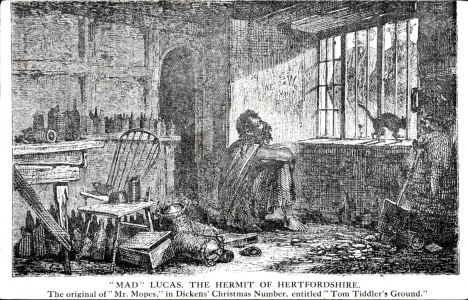|
James Lucas - The Hertfordshire Hermit of Redcoat's Green Great Wymondley |
 |
|
"Mad Lucas" The Hermit of Hertfordshire (undivided back post card, no publisher, circa 1903) |
|
James Lucas - The Hertfordshire Hermit of Redcoat's Green Great Wymondley |
 |
|
"Mad Lucas" The Hermit of Hertfordshire (undivided back post card, no publisher, circa 1903) |
|
Mad James Lucas the Hermit of Redcoats Green (Source: Stevenage Museum, 1976) James Lucas was the son of a very rich Liverpool businessman and land-owner, who owned large sugar plantations in the West Indies and - until emancipation - many slaves, James was born in 1811 and when he was about ten years old the family came to settle on the family estate at Great Wymondley, near Stevenage, Elmwood House, the family house, was a moderate sized country house at the hamlet of Redcoat's Green between Stevenage .and Hitchin. James Lucas was always a moody and eccentric boy and grew more so as he grew up: he alarmed the countryside by wildly riding about, tied by a cord to an old fashioned saddle, his long hair flowing behind. In 1849 James' mother, to whom he was devoted, died and James became rather more than eccentric. For 13 weeks he refused to have her buried but sat constantly by the coffin until the magistrates ordered burial. James Lucas had inherited Elmwood House, as well as a large fortune: his brother left at once, all the servants were dismissed and James became a complete recluse. All the rooms of the house were shut up and James lived in the kitchen, which contained nothing but one table and one chair. He wore only a blanket but never allowed the fire to go out: as the ashes accumulated, he scraped them back with his hand and they gradually filled the whole room. In this room James lived, black with soot and filth, for he slept on the ashes and never washed, for 25 years. James' terror of his relatives and others made him bar all the windows and doors with logs and iron bars. He lived mainly on bread and milk, the milk can padlocked while it was brought from the farm, the bread chosen from a number of loaves. Towards the latter part of his life he employed two watchmen.As his fame spread, Mad James Lucas received an increasing number of visitors to whom he talked for hours through the barred window. He was a highly intelligent man and had an excellent memory. His favourite visitors, however, were tramps and children. Tramps he would closely question and if they could give a convincing account of themselves he would give Protestants a penny and Catholics two pence, but if he caught them lying he swore at them and sent them away with no money or gin. He was happiest talking to children and used to distribute pennies, buns and sweets to dozens of children on Good Friday and Christmas Day. In 1861 Charles Dickens, who frequently stayed with Bulwer Lytton at Knebworth House a few miles to the south, paid a visit to James Lucas (although the hermit later denied he ever came). Dickens wrote a semi-fictional account of this visit which was published under the title 'Tom Tiddler's Ground': the description of 'Mr, Mopes' the hermit, a morbid and misanthropical man, secluding himself for the sake of notoriety, probably helped further to embitter James Lucas. The 'Hermit of Redcoats', as he became known, died in 1874 and was buried in the family vault in Hackney church. The decrepit house, in which completely furnished rooms had quietly rotted and mouldered away, was finally demolished in 1890. |
|
The Unoccupied Portion of the House, 1874 |
|
Extract from "Tom Tiddler's Ground" |
|
It was a nook in a rustic by-road, which the genius of Mopes had laid waste as completely as if he had been born an Emperor and a Conqueror. Its centre object was a dwelling-house, sufficiently substantial, all the window glass of which had been long ago abolished by the surprising genius of Mopes, and all the windows of which were barred across with rough-split logs of trees nailed over them on the outside. A rickyard, hip-high in vegetable rankness and ruin, contained out-buildings, from which the thatch had lightly fluttered away, on all the winds of all the seasons of the year, and from which the planks and beams had heavily dropped and rotted. The frosts and damps of winter, and the heats of summer, had warped what wreck remained, so that not a post or a board retained the position it was meant to hold, but everything was twisted from its purpose, like its owner, and degraded and debased. In this homestead of the sluggard, behind the ruined hedge, and sinking away among the ruined grass and the nettles, were the last perishing fragments of certain ricks; which had gradually mildewed and collapsed, until they looked like mounds of rotten honeycomb or dirty sponge. |
Sources
James Lucas (1813-1874) (Wikipedia)
Tom Tiddler's Ground (semi-fictional account by Charles Dickens, 1861)
Eccentric Characters: The Hermit of Redcoat Green (New York Times, 24 Jan 1875)
The Hermit of Hertfordshire, by G. Cowley (Pamphlet, front page illustrated in Hertfordshire People, December 2010)
Hertfordshire Express, 1902 (quoted as source for Stevenage Museum article)
Hermit Lucas (Hitchin Worthies, 1932)
Mad James Lucas: the Hermit of Redcoats Green (Stevenage Museum, 1976, quoted above)
The Hermit of Redcoats (Short article in Hertfordshire Curiosities, 1990)
Mad Lucas by Richard Whitmore, 1983
The Mad Hermit by Tony Phillips (Radio Play)
The Hermit of Redcoats is the name of a country pub and restaurant.
| November 2010 | Page Created | |
| January 2011 | Extract from Tom Tiddlers Ground |